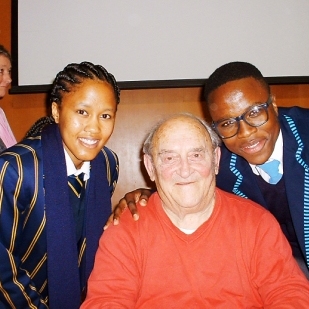
Lifestyle/Community

Many parallels between Anne’s story and apartheid history
MOIRA SCHNEIDER
PHOTOGRAPH BY MOIRA SCHNEIDER
CAPE TOWN
Pictured: Volunteer guides Luthando Diba of St Joseph’s Marist College (left) and Bathandwa Mki of Isilimela High School, flank Denis Goldberg at the opening of the Anne Frank exhibition at the Nelson Mandela Gateway, V & A Waterfront.
“Are we alert when we see this ‘othering’ again; have we learned the lesson?” the ambassador asked. “I think the answer is ‘No’,” she replied, listing the genocide in Rwanda, the war in Yugoslavia and apartheid in this country in support of her stance.
“We need these exhibitions and her story to remind us,” she said, adding that young people were “our beacon of hope”. Here she was referring to the 14 grade 10 learners who had volunteered to be guides at the exhibition, despite the fact that the period fell over their school holidays.
“You can tell the story like no other can and relate it to your reality,” she said addressing the volunteers.
The exhibition, a joint venture of the Cape Town Holocaust Centre (CTHC) and the Robben Island Museum, tells the story of Anne Frank against the background of the Holocaust and the Second World War. Director of the CTHC Richard Freedman spoke of the special connection between the young girl and the political prisoners of Robben Island.
The “Diary of Anne Frank” was one of the few books smuggled to them and proved to be a source of hope and inspiration, he said.
Sharing her personal memories, the ambassador recalled the effect that the young heroine’s story had had on her childhood. “Anne Frank plays a very special role in the life of every Dutch girl. All would read her diary; we could all very easily relate to it.”
After the war, Ambassador Gerard’s mother had met Miep Gies, who brought the Frank family food and news daily while they were in hiding and had found Anne’s diaries after their deportation to Auschwitz concentration camp.
“She shared her feelings of grief and guilt at not being able to rescue the family,” the ambassador remembered being told.
Rivonia Trialist Denis Goldberg, who was the keynote speaker at the event, noted that Anne had longed for the freedom to see the sun rise and hear the birds singing, feelings with which he could identify. “I lived for 22 years in prison and I desperately wanted to hear the birds sing and open the window and feel the raindrops,” he recalled.
Referring to the six million Jews who had perished, he said that 20 million others had also died during the Nazi era, “equally a tragedy, but they hardly get mentioned. One in every 100 Germans was murdered by the Nazis – let’s not forget that.”
Goldberg said that today “Jews in general have a terrible reluctance to accept ordinary German people”.
As to the relevance of those events for us today, he noted that the system of apartheid had also led to the deaths of millions through starvation and disease.
“In the rural areas of the eastern Cape, half of all kids under five died in apartheid times. We don’t talk about this, only about the brutality and the oppression.
“We whites claim we were civilised, but we allowed this to happen. People were killed judicially and extra-judicially.
“There was imprisonment of women and children for throwing stones – what sort of a people takes action against children?” he asked.
In the face of increasing ethnic hostility, the Holocaust Centre was holding the exhibition “to remind us how deep are the roots of intolerance”.




